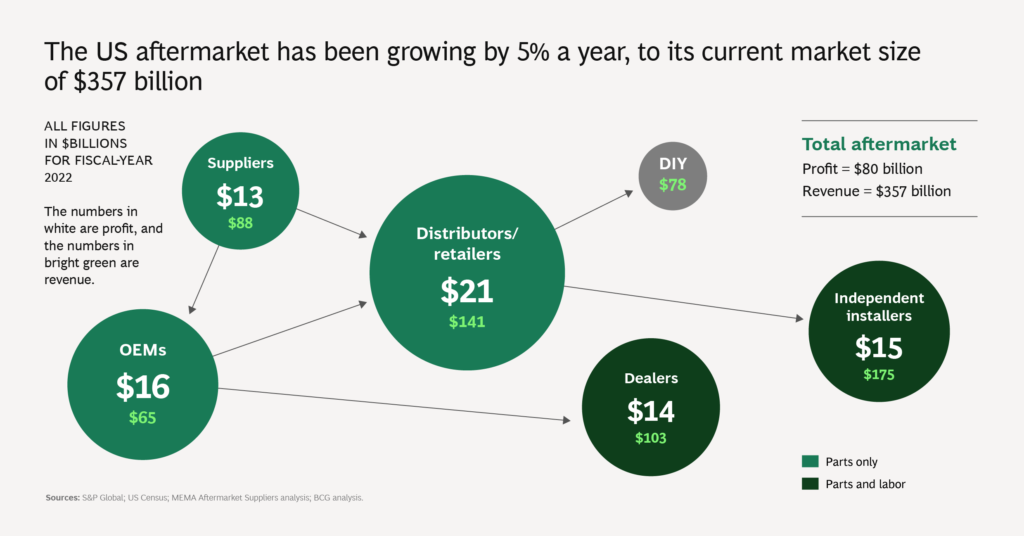The automotive industry is rapidly moving towards a future of software-based vehicles that includes advanced connectivity and high-performance computing. This shift creates tremendous excitement for new technologies and innovative features that will transform the ownership experience. The software in these vehicles allows, among other things, remote diagnostics, during which repairs and maintenance are coordinated in advance or carried out remotely, completely outside the shop.
But as these vehicles of the future gradually take over the roads, will they be a boon or a burden to the massive aftermarket industry—worth $357 billion in the US alone by 2022? And how should all actors in the value chain supporting software-based cars prepare?
To find answers, Sources collaborated with MEMA aftermarket vendors to examine the impact of software-enabled cars on key segments of the US auto aftermarket: parts suppliers, original equipment manufacturers (OEMs), distributors and dealers, independent installers, and dealers.
We evaluate each in five capability categories: diagnostics and updates, new services and business models, performance optimisation, data monetization, and maintenance planning. By taking a rigorous and deliberate approach to creating the new capabilities needed to address these use cases, aftermarket players have a once-in-a-generation opportunity to capture these benefits.

Challenges and opportunities for aftermarket players
Here are some key findings from the study:
The transition to software-based vehicles will modestly reduce aftermarket sales but increase profitability. The average amount American owners spend to maintain or improve their vehicles will drop about 8 percent to $1,150 in 2032, largely because electric vehicles become more common and have fewer parts to repair or replace.
But with services and solutions like advanced driver assistance and in-vehicle infotainment bringing in big margins, profit per vehicle is expected to grow about 13% to $315 a year in the period. Overall, aftermarket revenue will decline slightly by 2030, but overall industry profits will increase by about $2 billion.
By 2032, up to $4 billion of benefit transfers will be available across the value chain. However, growth opportunities are not evenly distributed in the aftermarket value chain. Auto OEMs and their suppliers are in the best position to find value because connectivity gives them a better direct link to customers—especially if regulators don’t introduce laws to mandate repairs that open up systems to third-party developers and service providers. Brick-and-mortar retailers are at the greatest risk of losing business. Profitable funds are undergoing an even greater shift as major players realize the value of new use cases and reduce the share of players that focus only on established aftermarket offerings. Although it will take another decade before connected cars make up half of the light vehicles on American roads, aftermarket suppliers need to pick up the pace now. It takes an average of eight years or more to build the technical capacity and infrastructure needed to compete.
Keys to success in the aftermarket of the future

The evolving automotive aftermarket offers great opportunities for companies in every segment of the value chain. However, all operators have one common requirement: they need to improve the experience of their customers by reducing the frequency of painful and time-consuming repair centres. This means moving to a seamless remote service model. Taking advantage of opportunities and becoming a winner requires the following skills:
Providers stand to gain more than a billion dollars in new features and services enabled by technology. They should develop solutions that complement physical components and user interfaces that help customers easily navigate core functions such as direct marketing and product development data.
OEMs can also earn more than $1 billion in new service offerings. To do this, they must develop modern software architectures and scalable cloud and data infrastructure, as well as agile product development methodologies that enable them to rapidly launch and improve digital offerings.
Distributors and dealers have more than $430 million in opportunities to leverage vehicle data to optimise their operations. They must adapt to more complex operations with advanced data analysis and artificial intelligence capabilities. Additionally, they are well positioned to provide installers and technicians with the knowledge and expertise needed to maintain software-configured vehicles.
Dealers have a great opportunity to win the loyalty of aftermarket customers if they take the initiative themselves. Since newly introduced software-defined warranty vehicles are likely to go to dealerships first, dealers can extend their customer relationships beyond the warranty period and beyond the first owners by taking advantage of the opportunity to provide an excellent customer experience.
Independent installers have the ability to do more technical repairs and compete for better customer service. They must be able to differentiate between maintenance and advanced repair options as the fleet transitions to software-defined vehicles.
While software-defined vehicles are only slowly becoming a common sight on American roads, technology trends and development paths for leading OEMs are set, and consumerism is accelerating quickly. Aftermarket suppliers need to start transitioning to a software-defined future now.
Source: BCG
Get more latest Knowledge Centric and insight driven content on Automobile Industry.





Leave a Reply